Comet NEOWISE at dusk. Comet NEOWISE still hangs in the northwest in late twilight. Plan to look for it 1½ hours after your local sunset time, less long after if you're in the latitudes of the American South. The comet has been fading a little slower than predicted; it was still hanging on at 3rd magnitude as of July 18th, and its increasing altitude every evening helps. The comet is passing closest to Earth this week, though it's receding from the Sun.
To find it, spot the Big Dipper high in the northwest toward the end of twilight as the stars come out. The comet is below the Dipper's bowl, as shown below, by 20° to 15°. That's about two fists to one and a half fists at arm's length.
You may or may not need binoculars to detect it, depending on the state of twilight, light pollution, and the clarity of your sky low in the northwest. See Bob King's new article, Comet NEOWISE Dazzles at Dusk.
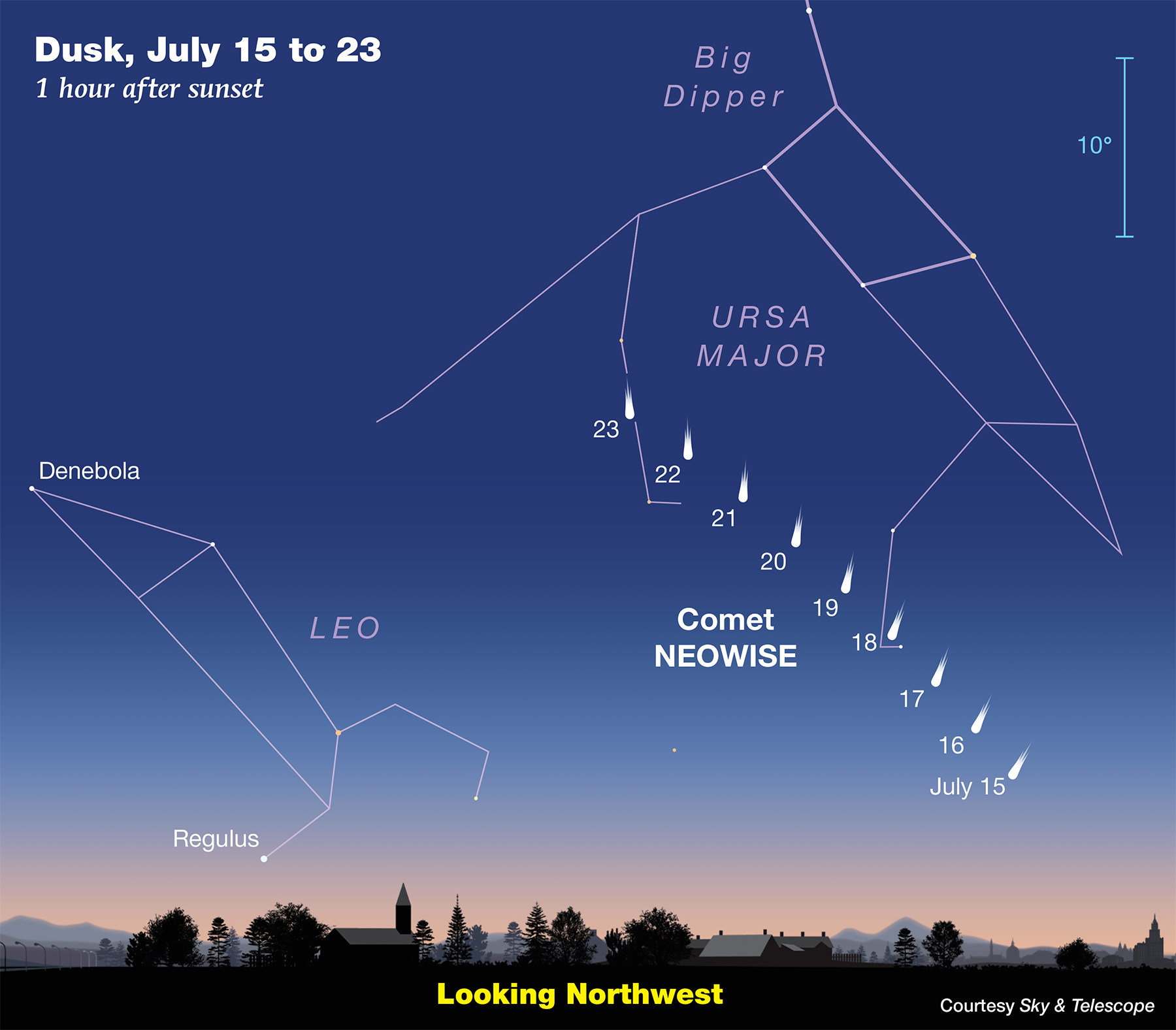
Two supernovae for amateur telescopes continue in the western evening sky, both still magnitude 12 or 12½. Both are in the Virgo Galaxy Cluster, in the edges of M85 and NGC 4457, which are getting a little lower in the west every day. Hunt them out right after the end of twilight with a 6-inch or larger scope, using the finder charts and photos in Bob King's Two Bright Supernovae Light Up Nearby Galaxies.
FRIDAY, JULY 17
■ Toward the end of twilight once the stars come out, binoculars will help show that Comet NEOWISE is close to the star-pair Iota and Kappa Ursae Majoris, magnitudes 3.1 and 3.6 respectively, 1.1° apart. They form Ursa Major's front paw as shown above. Nice photo opportunity for a telescope or a very long lens.
■ In dawn on Saturday morning the 18th, Venus and the thin crescent Moon help guide your way to low little Mercury as shown below. Mercury, still only magnitude +0.9, is just beginning a couple weeks of fairly good dawn visibility.
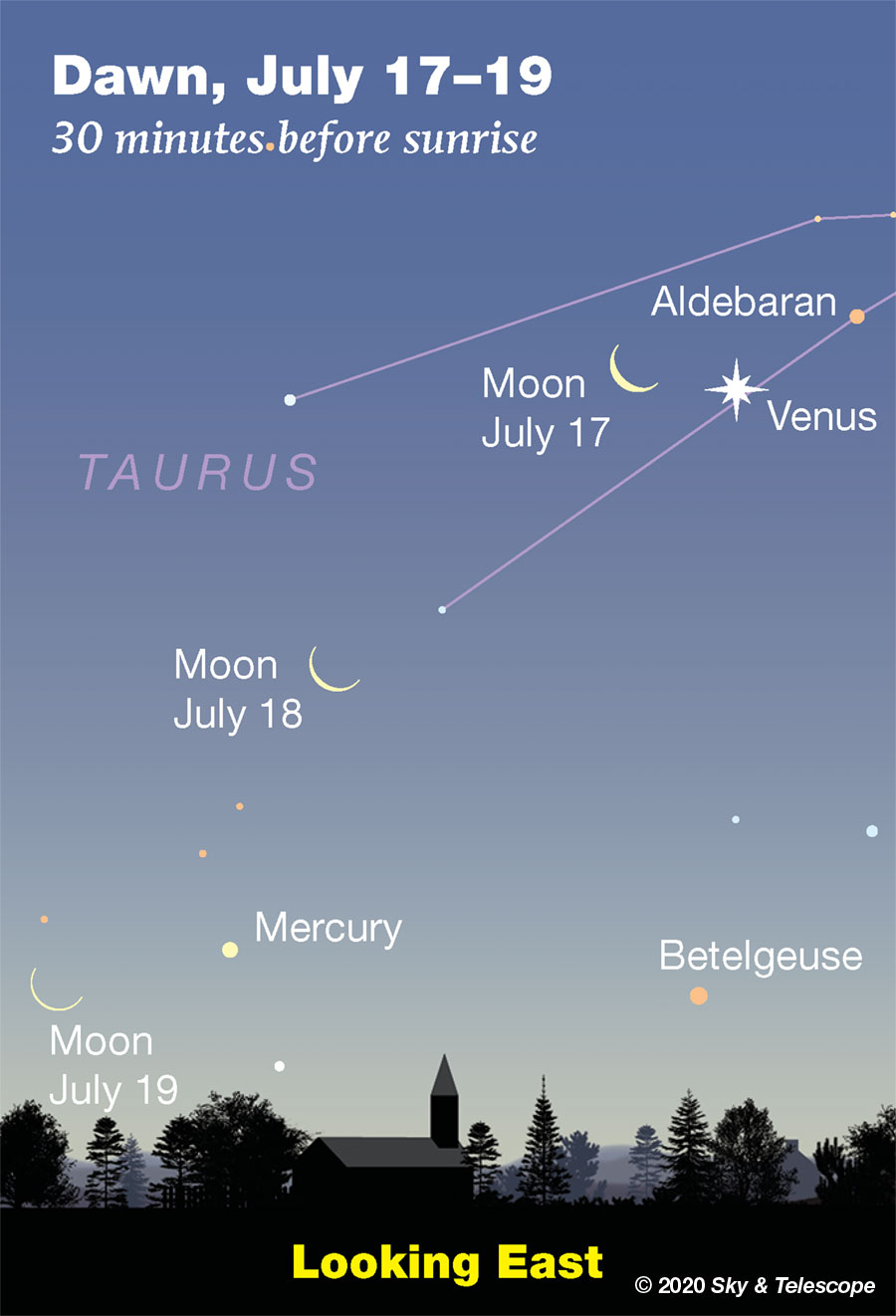
SATURDAY, JULY 18
■ If you have a dark enough sky, the Milky Way now forms a magnificent arch high across the whole eastern sky after nightfall is complete. It runs all the way from below Cassiopeia in the north-northeast, up and across Cygnus and the Summer Triangle in the east, and down past the spout of the Sagittarius Teapot in the south-southeast.
Meanwhile the Big Dipper, high in the northwest after dark, is dipping down to "scoop water" through the evenings of summer and early fall.
SUNDAY, JULY 19
■ After nightfall, spot Altair in the east-southeast. It's the second-brightest star on the whole eastern side of the sky, after Vega high to its upper left.
Above Altair by a finger-width at arm's length is little orange Tarazed. A bit more than a fist to Altair's left or lower left is little Delphinus, the Dolphin, leaping leftward.
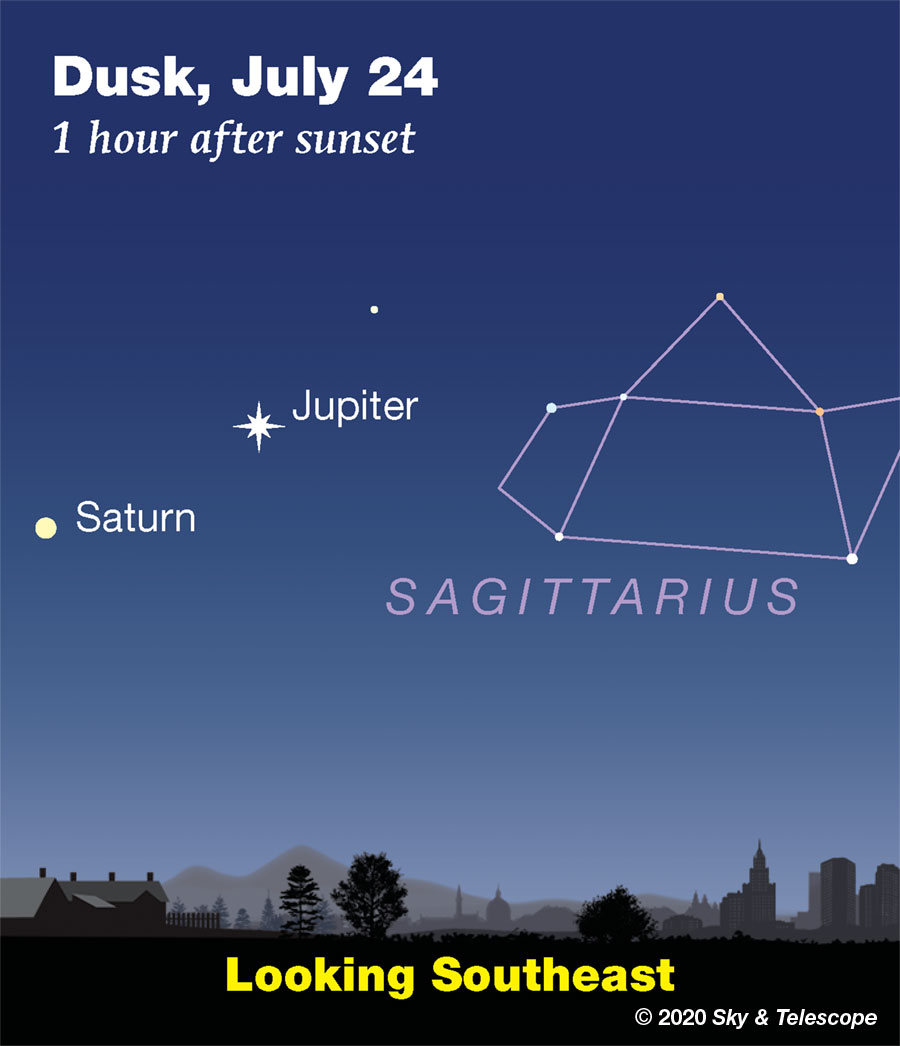
MONDAY, JULY 20
■ Fourth star of the Summer Triangle. The big Summer Triangle of Vega, Deneb and Altair is high in the east these evenings. Vega, the brightest, is its top star. Deneb is to Vega's lower left, and Altair is farther to Vega's lower right.
The next-brightest star near the Summer Triangle, if you want to turn it into a quadrilateral, is Rasalhague, the head of Ophiuchus. Face Altair soon after dark. You'll find Rasalhague about equally far to the lower right of Vega and upper right of Altair.
■ New Moon (exact at 1:33 p.m. EDT).
TUESDAY, JULY 21
■ We're not yet halfway through summer, but already W-shaped Cassiopeia, a constellation of fall and winter evenings, is climbing up in the north-northeast as evening grows late. And the Great Square of Pegasus, emblem of fall, rises to balance on one corner just over the eastern horizon.
WEDNESDAY, JULY 22
■ Saturn is at opposition. In a telescope, do you notice that Saturn's rings are distinctly brighter, compared to Saturn's globe, than they usually are? This so-called Seeliger effect is caused by the solid ring particles backscattering sunlight to us when the Sun is almost directly behind us. The dusty surfaces of the Moon and Mars do this too, but Saturn's clouds do not. In the case of Saturn the effect is named for Hugo von Seeliger, who studied it in detail and published in 1887.
■ Three doubles at the top of Scorpius. The head of Scorpius — the near-vertical row of three stars to the right or upper right of Antares — stands in the south-southwest right after dark. Look very far to the right of Jupiter and Saturn.
The top star of the row is Beta Scorpii or Graffias, a fine double star for telescopes, separation 13 arcseconds.
Just 1° below Beta is the very wide naked-eye pair Omega1 and Omega2 Scorpii, not quite vertical. They're both 4th magnitude and ¼° apart. Binoculars show their slight color difference; they're spectral types B9 and G2.
Left of Beta by 1.6° is Nu Scorpii, another fine telescopic double, separation 41 arcseconds. Or rather triple. High power in good seeing reveals Nu's brighter component itself to be a close binary, separation 2 arcseconds and aligned almost north-south.
THURSDAY, JULY 23
■ One of the nice summer star clusters for binoculars is IC 4665 just above the eastern shoulder of Ophiuchus. It's large but sparse, with ten 7th- and 8th-magnitude stars spanning about a third of a degree. In a telescope they seem to me spell, raggedly, the greeting "HI" (when south-southwest is oriented up).
Why does an object this noticeable bear only an IC number? It was independently discovered and recorded at least four times between 1745 and 1908, when, finally, Solon Bailey at Harvard added it into the Index Catalogue being appended to the NGC. See Matt Wedel's Binocular Highlight story and chart in the July Sky & Telescope, page 43.
FRIDAY, JULY 24
■ As summer progresses, bright Arcturus is moving down the western side of the evening sky. Its pale ginger-ale tint always helps identify it.
Arcturus forms the bottom point of the Kite of Bootes. The Kite, rather narrow, extends upper right from Arcturus by 23°, about two fists at arm's length. The top of the kite is bent slightly down, as if something banged into it.
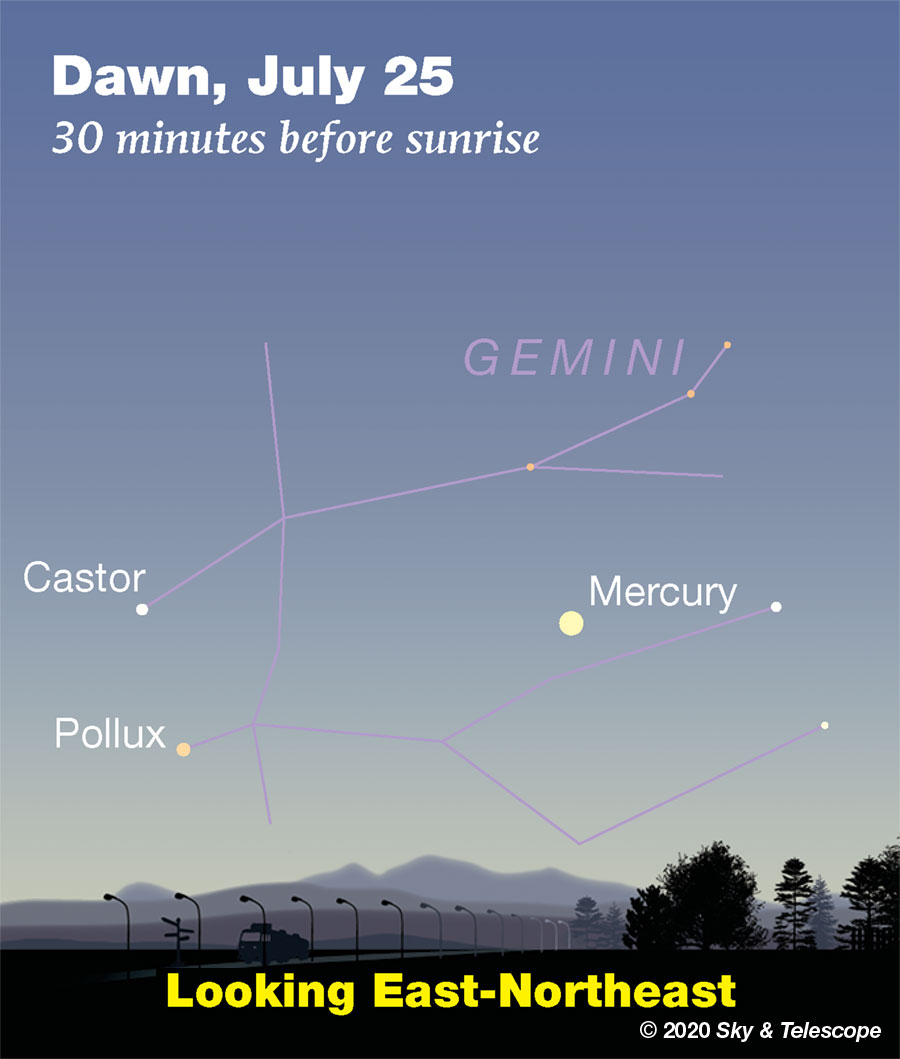
SATURDAY, JULY 25
■ The Sagittarius Teapot is in the south these evenings; find it right of Jupiter and Saturn. With the advance of summer, the Teapot is starting to tilt and pour from its spout to the right. The Teapot will tilt farther and farther for the rest of the summer — or for much of the night if you stay out late.
■ The tail of Scorpius is low in the south soon after dark, lower right of the Teapot by hardly a fist at arm's length. How low this whole scene is depends on how far north or south you live: the farther south, the higher.
Look for the two stars especially close together in the tail. These are Lambda and fainter Upsilon Scorpii, known as the Cat's Eyes. They're canted at an angle; the cat is tilting his head and winking.
A line through the Cat's Eyes points west (right) by nearly a fist-width toward Mu Scorpii, a much tighter pair known as the Little Cat's Eyes. They're oriented almost exactly the same way as Lambda and Upsilon. Can you resolve the Mu pair without using binoculars? It takes sharp eyes!
This Week's Planet Roundup
Mercury becomes visible very low in the dawn this week, as shown above. Mercury remains at about the same height from morning to morning, even as it brightens from a puny magnitude +0.9 on July 18th to –0.2 on the 25th. That's almost three times brighter! It's because Mercury is swinging around the Sun and showing us more of its sunlit side.
Venus (magnitude –4.6) rises in deep darkness about an hour before the beginning of dawn. As dawn gets under way, Venus blazes brightly in the east.
Look for Aldebaran, much fainter at 1st magnitude, moving farther away to Venus's upper right each morning. The Pleiades glimmer farther above Aldebaran. The bright star much farther to Venus's upper left is Capella.
In a telescope Venus is a thick crescent, shrinking this week from 33 to 30 arcseconds tall and waxing from 33% to 39% sunlit.
Mars rises due east by about midnight daylight saving time, shining bright orange (magnitude –0.7) between Pisces and Cetus. Watch for it to rise below the Great Square of Pegasus. By the dawn Mars shines grandly high and bright in the south-southeast, like a far-off bonfire in the heavens.
In a telescope this week Mars grows from 13 to 13.5 arcseconds in apparent diameter; Earth is approaching it in our faster orbit around the Sun. Mars is still very gibbous, 85% sunlit. Look for its white South Polar cap and for subtler dark surface markings. To get a map of the side of Mars facing you at your date and time, use our Mars Profiler. The map there is rectangular; remember to mentally wrap it onto the side of a globe.
Jupiter and Saturn (magnitudes –2.8 and +0.1, respectively) are at opposition this month: Jupiter on the night of July 13th, Saturn on the 20th. So they rise around sunset, loom low in the southeast in twilight, and climb higher as the evening grows late. Jupiter is brightest; Saturn is 7° to its lower left. Farther to Jupiter's right, look for the Sagittarius Teapot.
The two planets are highest in the south around midnight. Keep up with the telescopic interplay of Jupiter with its moons and their shadows, and find all the transit times of Jupiter's Great Red Spot, in the July Sky & Telescope, page 50.
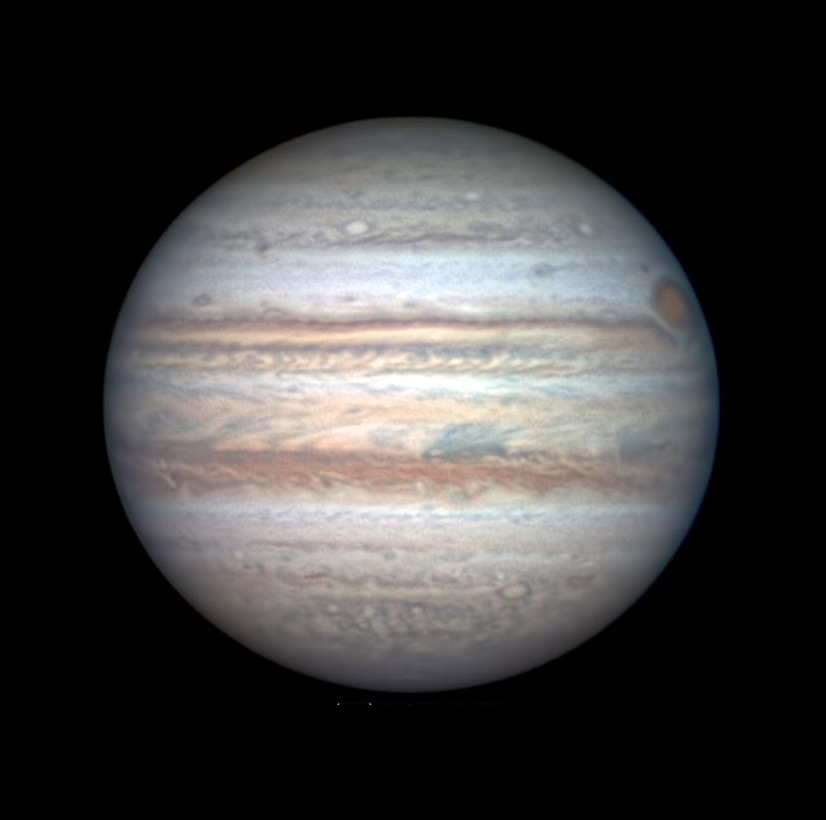
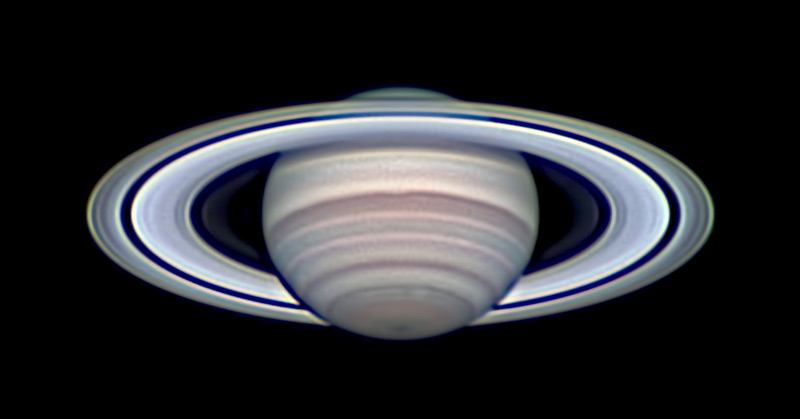
Uranus (magnitude 5.8, in Aries) is high in the east before dawn, far to the celestial east of Mars.
Neptune (magnitude 7.9, in Aquarius) is high in the south before dawn, far to the west of Mars.
All descriptions that relate to your horizon — including the words up, down, right, and left — are written for the world's mid-northern latitudes. Descriptions that also depend on longitude (mainly Moon positions) are for North America.
Eastern Daylight Time, EDT, is Universal Time (also known as UT, UTC, GMT, or Z time) minus 4 hours.
Want to become a better astronomer? Learn your way around the constellations. They're the key to locating everything fainter and deeper to hunt with binoculars or a telescope.
This is an outdoor nature hobby. For an easy-to-use constellation guide covering the whole evening sky, use the big monthly map in the center of each issue of Sky & Telescope, the essential magazine of astronomy.
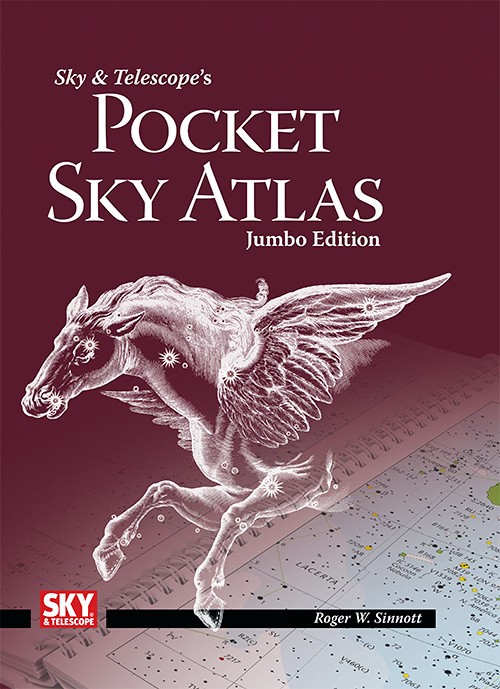
Once you get a telescope, to put it to good use you'll need a detailed, large-scale sky atlas (set of charts). The basic standard is the Pocket Sky Atlas (in either the original or Jumbo Edition), which shows stars to magnitude 7.6.
Next up is the larger and deeper Sky Atlas 2000.0, plotting stars to magnitude 8.5; nearly three times as many. The next up, once you know your way around, are the even larger Interstellarum atlas (stars to magnitude 9.5) or Uranometria 2000.0 (stars to magnitude 9.75). And read how to use sky charts with a telescope.
You'll also want a good deep-sky guidebook, such as Sky Atlas 2000.0 Companion by Strong and Sinnott, or the bigger (and illustrated) Night Sky Observer's Guide by Kepple and Sanner.
Can a computerized telescope replace charts? Not for beginners, I don't think, and not on mounts and tripods that are less than top-quality mechanically, meaning heavy and expensive. And as Terence Dickinson and Alan Dyer say in their Backyard Astronomer's Guide, "A full appreciation of the universe cannot come without developing the skills to find things in the sky and understanding how the sky works. This knowledge comes only by spending time under the stars with star maps in hand."
![]() Audio sky tour. Out under the evening sky with your
Audio sky tour. Out under the evening sky with your
earbuds in place, listen to Kelly Beatty's monthly
podcast tour of the heavens above. It's free.
"The dangers of not thinking clearly are much greater now than ever before. It's not that there's something new in our way of thinking, it's that credulous and confused thinking can be much more lethal in ways it was never before."
— Carl Sagan, 1996
"Facts are stubborn things."
— John Adams, 1770
 0
0








Comments
You must be logged in to post a comment.